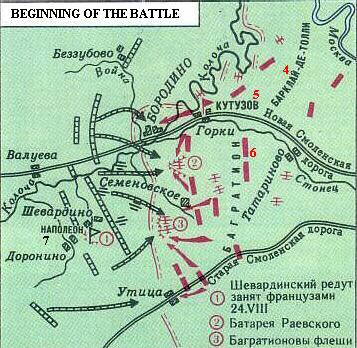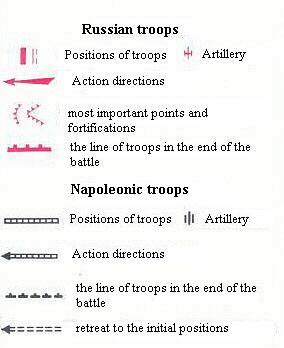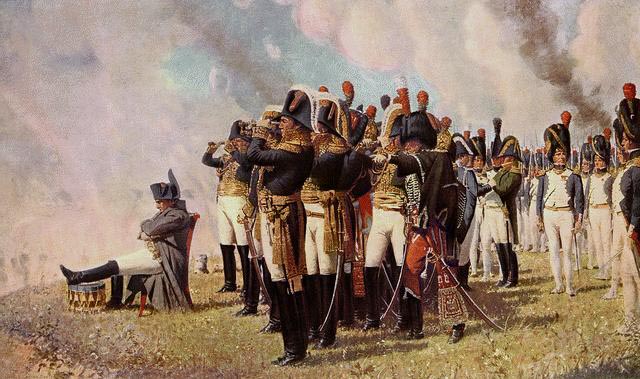September, 7 (August,26)
(From L.G.Beskrovny "The Borodino Battle", Moscow, 1971,
L.G.Beskrovny "Russian Military Art of XIX Century", Moscow,1988
P.A.Zhilin "The Patriotic War Of 1812",
D.Bantish-Kamensky "The Biographies of The Russian Generalissimos And Field-Marshals", vol. 3, Moscow, 1840,
F.N.Glinka "The Sketches Of The Borodino Battle" from the book "1812 Year In Memoirs Of Contemporaries", Moscow,1987)
What forces were facing each other on the Borodino field at daybreak on that day, September 7, 1812, one of the bloodiest days in human history? The Russian army, under the overall command of Kutuzov, consisted of the following forces:
- The right wing and the center, under the command of Barclay de Tolly,and directly commanded by General Miloradovich. This was two Infantry Corps: the 2nd and the 4th Corps (19800 men), and two Cavalry Corps - the 1st and the 2nd (6 thousand men), in total - 25800 men.
- The center of the Russian army, under the command of General Dokhturov, was made up of one Infantry and one Cavalry Corps, totaling about 13600 men.
- The reserves of the center and right wing (about 36300 men) was at Kutuzov's disposal. The total number of troops on the right wing and center was approximately 75,700.

|

|
|
|
A great deal of importance was attached to reserves. The presence of big reserves and the artillery attached to them made it possible to fight long battles, hopefully wearing out the enemy. Kutuzov wrote, "reserves must be preserved as as long as possible, because a general who can save his reserves is not yet defeated".
The mass of troops (the right wing and the center) was called "The 1st Army" because the main body of them was the former 1st Western Army of Barclay de Tolly.
Bagration commanded the left wing, and because the base of this was the 2nd Western Army that was commanded by Bagration before Smolensk, the left wing was called "the 2nd Army" and Bagration was called "the second Commander-in-Chief".
The left wing consisted of two Infantry Corps (22 thousand men), and one Cavalry Corps - 3800 men, with reserves of about 8300. So before the battle, Bargation had a total of 34,100 men - less than half the size of the 1st Army. Besides these regular troops with reserves, numbering a total of 100,800 men, about 7000 cossacks and 10,000 militiamen ("ratniks") joined the Russian Army. Kutuzov commanded had about 120,800 men under arms, not counting the Cossacks. And 640 artillery guns.
These numbers are quoted in many sources, but the number given by Toll is less: "On this day, the Russian army had 95 thousand line troops and artillery, 7 thousand Cossacks and 7 thousand of the Moscow militia ("Opolchenie"), and 7 thousand of the Smolensk Militia. In total: 112 thousand men and 640 artillery guns".

Napoleon at Borodino
The picture by Vereschagin
Napoleon brought to the Borodino field (by exaggerated Russian calculation) five Infantry Corps: the 1st, 3rd, 4th, 5th and 8th; four Cavalry Corps, and the Old and Young Guard.
The Infantry Corps totaled 122 thousand men, the four Cavalry Corps - 22,500 men, 13 thousand in the Old Guard, in the Young Guard - 27 thousand men. In all (calculated by the Russian Headquarters) Napoleon had 185 thousand men.
The 1st Corps (the largest of the five Corps) consisting of 48 thousand men, was under the command of Marshal Davout. The 3rd Corps (20 thousand men) was under the command of Marshal Ney. Vice-King of Italy Eugene de Beauharnais commanded the 4th Corps (24 thousand men). Prince Poniatowsky commanded the 5th Corps (17 thousand men). the 8th Corps (13 thousand men) was under the command of General Junot men). All the French Cavalry was under the command of King of Naples, Joachim Murat (22500 men).
Napoleon was, of course, the Commander-in-Chief of all the Great Army. but he was also The main commander of the Old and Young Guards, though the direct commander of the Old Guard was Marshal Mortier, and Marshal Lefebre commanded the Young Guard.
In the real world, as calculated by von Clausewitz, who was a historian and a participant of these events, and accepted now by the modern military historiography, when Napoleon came to Smolensk, he had about 182 thousand men, but when he came to the Borodino field he had 130 thousand men and 587 guns. 52 thousand were lost before the Borodino battle: 36 thousand men Napoleon lost in the battles at Smolensk and Valutina Hill and in the numerous small combats and affairs from Smolensk to Shevardino. There were also ill and fallen-behind soldiers (1) ; and Napoleon had sent 10 thousand to reinforce the garrison of Vitebsk, and 6 thousand he left in Smolensk.
These numbers are given by the French military historians of this campaign, and were used by Clausewitz after verification.
- Clausewitz "The Year of 1812", p.82
